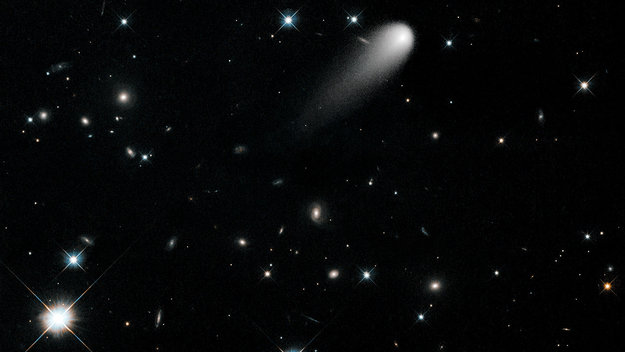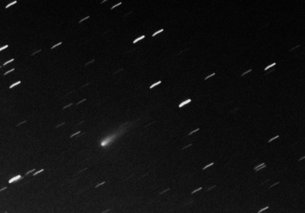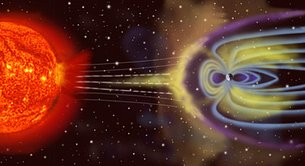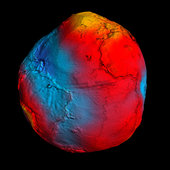Image above: Technicians and engineers oversee
MAVEN after it was attached to a processing stand.
Image Credit: NASA/Tim Jacobs
Image Token:
By Steven Siceloff,
NASA's Kenendy Space Center
MAVEN's approach to Mars studies will be quite different from that taken by
recent probes dispatched to the Red Planet. Instead of rolling about on the
surface looking for clues to the planet's hidden heritage, MAVEN will orbit high
above the surface so it can sample the upper atmosphere for signs of what
changed over the eons and why.
The mission will be the first of its kind and calls for instruments that can
pinpoint trace amounts of chemicals high above Mars. The results are expected to
let scientists test theories that the sun's energy slowly eroded nitrogen,
carbon dioxide and water from the Martian atmosphere to leave it the dry,
desolate world seen today.
"Scientists believe the planet has evolved significantly over the past 4.5
billion years," said David Mitchell, MAVEN's project manager for NASA's Goddard
Spaceflight Center in Maryland. "It had a thicker atmosphere and water flowing
on the surface. It wasn't like Earth, but it was not like it is today."
Before any of those studies can take place at Mars, though, the spacecraft
will see a few months of intense launch processing at NASA's Kennedy Space
Center in Florida. The MAVEN spacecraft, short for Mars Atmosphere and Volatile
Evolution, stands inside the Payload Hazardous Servicing Facility at Kennedy
where engineers and technicians are taking the first steps in getting it ready
for launch in November.
The instruments, systems and all-important power-generating solar array wings
on the 5,400-pound spacecraft (once fueled) will be tested repeatedly inside the
clean room at the Kennedy facility. Engineers also will fuel the spacecraft so
it can maneuver through space and arrive safely in orbit around Mars.
MAVEN arrived at Kennedy Aug. 2 on a C-17 transport aircraft.
"A big part of our schedule was getting to the Cape on time," Mitchell said.
"We have marked this as a big milestone we had to hit because if you miss this
launch period, you stand down for 26 months until the planets are aligned
again."
Technicians spent the first week reinstalling equipment that was removed for
the flight such as the high-gain antenna the spacecraft uses to transmit data to
Earth.
The spacecraft will be powered on during its second week at Kennedy and tests
will begin in earnest soon afterward, Mitchell said.
When the testing and fueling is complete, a payload fairing will be placed
around MAVEN and it will be trucked to Launch Complex 41 at Cape Canaveral Air
Force Station. MAVEN will be hoisted atop a United Launch Alliance Atlas V for
launch Nov. 18 to begin a 10-month cruise to Mars.
Testing the MAVEN calls for stringent guidelines since the spacecraft will
face the stresses of spaceflight throughout its mission. For example, the two
solar arrays will have to withstand differing pressures of flying from the
vacuum of space to even the tenuous layers of the Martian upper atmosphere
during each orbit.
MAVEN carries instruments that can take samples of the Martian atmosphere
directly when it flies as low as 77 miles above the surface, plus devices that
will analyze the planet from more than 3,700 miles away.
"MAVEN is going after something the others haven't," Mitchell said. "It's
going to look at the current composition of the upper atmosphere and how solar
storms and other factors changed the atmosphere. We’ll then be able to project
back in time to see how it was in an earlier epoch."
The MAVEN flight comes on the heels of remarkable successes by NASA's Mars
exploration efforts, including the landing a year ago of the rover Curiosity
that has conducted detailed geological studies on the Martian surface.
"MAVEN will help us understand the climate history, which is the history of
habitability.” said Bruce Jakosky, planetary scientist at the University of
Colorado Boulder and MAVEN's principal investigator, “Although MAVEN is not
going to detect life, it’s trying to understand the environment that might have
been able to support life.”
Mars has long intrigued NASA and planetary researchers for a host of reasons
including the fact that its surface does not look unlike some places on Earth,
although its atmosphere would be far from hospitable to humans. Since NASA
landed two Viking probes on the planet in 1976 and followed up with a series of
orbiters, landers and rovers from 1996 to last year, Earthbound observes have
been flabbergasted by numerous discoveries including the potential for abundant
liquid water.
"There's something about going to another planet that's very exciting,"
Mitchell said. "When you're talking about going to Mars, it isn't hard to get
great people to come work the job. And ultimately, the mysteries that MAVEN will
help decipher should be a treasure trove for the science
community.
NASA Offers Media Access to Next Mars Mission Spacecraft on Sept. 27
NASA’s next Mars-bound spacecraft, the Mars Atmosphere and Volatile Evolution (MAVEN) will be the focus of a media opportunity on Friday, Sept. 27, at NASA’s Kennedy Space Center in Florida.
The event at the Payload Hazardous Servicing Facility is an opportunity to photograph MAVEN and interview project and launch program officials. MAVEN will be seen with its solar arrays deployed. MAVEN is targeted to launch from nearby Cape Canaveral Air Force Station’s Complex 41 atop a United Launch Alliance Atlas V rocket on Nov. 18.
There will be two opportunities to photograph the spacecraft on Sept. 27. For the first opportunity, media will begin boarding buses at 8:15 a.m. EDT at the Kennedy Press Site for transportation to the facility. Return to the press site is expected by 11:45 a.m. For the second opportunity, media will begin boarding buses at 11:15 a.m. Return to the press site is expected by 2:45 p.m.
Because of the limited number of people permitted in the cleanroom, only two representatives from a media organization will be allowed to participate. No more than 20 participants will be allowed to sign up for each of the two opportunities, which are on a space-available basis.
All media must RSVP for this event no later than Sept. 24 and specify the preferred opportunity. Contact Jennifer Horner at 321-867-6598 or
jennifer.p.horner@nasa.gov.
U.S. news media requiring credentials also must apply for accreditation by Sept. 24. Two forms of government-issued identification are required to receive a badge, one with a photograph such as a driver’s license or passport. Badges will be available for pick up at the Kennedy Badging Office, located on State Road 405 east of the Kennedy Space Center Visitor Complex. Hours for the Kennedy Badging Office are 6 a.m. to 3 p.m. Journalists needing accreditation should apply online at:
Individuals entering the cleanroom where the spacecraft is being prepared for launch must follow procedures for optically sensitive spacecraft. Full cleanroom attire (bunny suits) will be furnished and must be worn. Perfume, cologne and makeup are not allowed. Long pants and closed-toe shoes must be worn. No shorts or skirts will be permitted.
Photographers will need to clean camera equipment under the supervision of contamination-control specialists. All camera equipment must be self-contained, and no portable lights will be allowed. Non-essential equipment, such as suede, leather or vinyl camera bags or other carrying cases, must be left outside the cleanroom. No notebook paper, pencils, or click-type ball point pens are permitted. Cleanroom paper will be provided. No food, tobacco, chewing gum, lighters, matches or pocketknives will be allowed. Use of wireless microphones and cellular telephones is not allowed inside the cleanroom. Electronic flash will be permitted. The lighting in the facility is high-pressure sodium (orange).
MAVEN is the second mission for NASA’s Mars Scout Program and will obtain critical measurements of the Martian atmosphere to help understand climate change over the Red Planet’s history.
MAVEN is the first spacecraft devoted to exploring and understanding the Martian upper atmosphere. It will orbit the planet in an elliptical orbit that allows it to pass through and sample the entire upper atmosphere on every orbit. The spacecraft will investigate how the loss of Mars’ atmosphere to space determined the history of water on the surface.
MAVEN's principal investigator is based at the University of Colorado Boulder's Laboratory for Atmospheric and Space Physics. The university will provide science operations, science instruments and lead education and public outreach. NASA's Goddard Space Flight Center in Greenbelt, Md., manages the project and provides two of the science instruments for the mission. Lockheed Martin of Littleton, Colo., built the spacecraft and is responsible for mission operations. The University of California at Berkeley Space Sciences Laboratory provides science instruments for the mission. NASA's Jet Propulsion Laboratory in Pasadena, Calif., provides navigation support, the Deep Space Network and the Electra telecommunications relay hardware and operations.
NASA’s Launch Services Program at Kennedy is responsible for launch management. United Launch Alliance of Centennial, Colo., is the provider of the Atlas V launch service.
For more information about the MAVEN mission, visit:




















